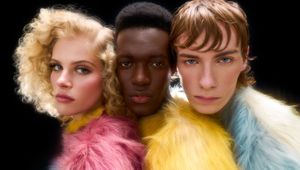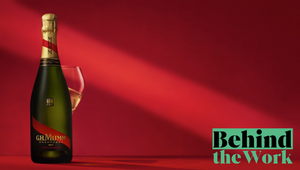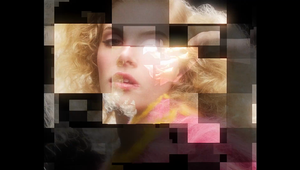
Caravane Puts Tangible Craftsmanship First

For ten years now, directors Jean-Constant Guigue and Francis Dakin-Côté – also known as Caravane – have been going against the grain. Despite the popularity of tools like CGI, the L’Éloi duo has always chosen to embrace craftsmanship first, prioritising things like physical set building, in-camera shooting, and practical effects – all in the service of creating an authenticity that digital simply can’t replicate.
However, times are changing. Everyone’s heard it by now, but AI well and truly is changing the playing field. The clear divide between CGI and real-world craft is blurring, and the capabilities of this technology have forced the pair to re-evaluate their systems. This begs the question: is there still room for a methodology such as theirs in this brave new world?
The answer, undoubtedly, still remains a resounding yes. While incredible in its capabilities, ultimately, Caravane has recognised that AI still remains a tool – like CGI once was – that can be used to push creative boundaries, rather than cut out the creative altogether. Best used to generate visual references which can then be turned into real, physical outputs, the secret lies in remembering that at the end of the day, its main purpose isn’t to replace creativity, but help enhance output. After all, there’ll always be room for the director duo’s love of building, sharing and creating real things alongside real people, so long as they continue to believe in the beauty of the process.
To learn more about their process and how AI has impacted it, LBB’s Jordan Won Neufeldt sat down with Caravane for a chat.
LBB> From the top, tell us about your directorial style. What defines it, and makes it uniquely yours?
Caravane> At Caravane, our directorial style is grounded in a love for tangible craftsmanship and in-camera effects. What makes our style unique is our commitment to creating real, physical elements in our visuals, as opposed to relying on CGI. We focus on bringing a distinctive warmth, depth, and authenticity to our projects by physically building sets and shooting real objects. This approach allows us to deliver work that feels organic, human, and deeply connected to reality.
Over the years, we've developed a style that blends artistry and technical precision, often creating moments that feel magical but remain grounded in physicality.
LBB> And why is embracing hands-on craftsmanship so important to you?
Caravane> Hands-on craftsmanship is at the heart of Caravane because it allows us to connect with the creative process in a visceral way. It’s important to us because we believe that the physical act of creating something real adds a layer of authenticity that is hard to replicate digitally.
We started as set designers and builders, and that has shaped our belief that the magic lies in the tactile, collaborative experience. Our approach isn't just about the final image, but about the energy and human connection that comes from working together in the same space, physically creating something.
LBB> Tell us more about this! How has your approach evolved throughout that time?
Caravane> Over the years, we’ve refined our craft and explored new ways to bring our vision to life, with plenty of creative territory still left to explore. While we started as purists, avoiding digital effects like CGI, we’ve gradually become more open to using tools like CGI and AI. However, we haven’t relied on them extensively, as there’s a certain magic and depth that only comes from creating things by hand – something that digital work can’t quite replicate. For us, these technologies should enhance the human element, not replace it.
LBB> You mentioned enabling a sense of human connection in your work via physical collaboration. Why is this so important from an artistic standpoint?
Caravane> From our artistic perspective, physical collaboration adds a human character and warmth that’s hard to replicate digitally. While some may find that same sense of connection working on computers, for us, the act of building real sets introduces a level of imperfection and authenticity that’s essential. Digital creations, while often striking, can sometimes fall into an uncanny valley where they look almost real but feel overly perfect, creating a sense of disconnect. In contrast, working with real materials brings the natural imperfections and nuances of the physical world, which adds honesty to the final product.
LBB> What do you think this approach offers that CGI can’t replicate?
Caravane> We like to say that there’s nothing more real than the real thing. When we create something physically, it brings a texture, weight, and natural imperfection that CGI struggles to convey. We frequently find ourselves explaining this when pitching our work against CGI-driven studios with similar styles. We believe CGI, like AI, works best when it pushes the boundaries of what's possible, rather than trying to mimic reality. For us, there’s a depth and tactile quality to in-camera effects that naturally invites the audience to engage with the work on a more emotional level.
LBB> Of course, we’re entering an era where more and more often, people are talking about AI. What are your initial thoughts on it and its place in the industry?
Caravane> AI, like CGI before it, is a tool that every creative should experiment with to discover its potential. In our case, we don’t see AI as a tool for creating final images, but it certainly helps us get there. We take a pragmatic approach, using AI to handle tedious tasks we’d rather avoid, giving us more time to focus on creativity and craft.
It’s important to recognise that AI isn’t just for writing text or generating images; its capabilities are far broader. You need to be as creative with AI as you are with your own craft. For us, AI is about making more room for creativity, doing more with less, and focusing on what matters, not replacing the human element at the heart of our work.
LBB> How has AI blurred the lines between CGI and real-world craft? What new angles are opening up because of this?
Caravane> In a way, AI is like a new superpower within CGI, enabling things that would be nearly impossible or too time-consuming to achieve with traditional tools. Every year, CGI tools improve, becoming more accessible and affordable, which has democratised creation. AI adds a fresh layer on top of this, offering a more intuitive, less predictable approach. While CGI is precise and reliable, AI works best with open-ended concepts, allowing for more spontaneous results. At Caravane, we sometimes sketch our sets in 3D for precision, with the intent to build them in the real world later. We view AI similarly – it’s a tool to generate ideas and visual references that can inspire the physical sets we create.
LBB> Do you think this change has positively impacted your work and approach for the better?
Caravane> AI has definitely had a positive impact on our workflow, mainly by saving us time and increasing efficiency. Creatively speaking though, we believe AI is still far from producing truly relevant or original work on its own. When you ask it to generate content on its own, the results tend to be clichéd and unoriginal. However, when guided by a human creative mind, AI can be incredibly useful. It’s all about experimenting, learning to harness its potential, and finding the right ways to use it in each of our processes. For us, it’s more about taming the tool and incorporating it into many small ways, rather than letting it drive the vision.
LBB> Can you give us some examples of work you were able to create by blending the best of both approaches?
Caravane> Our project for Bath & Body Works is a great example of how we used CGI and AI to create a 100% real spot, shot entirely in-camera. Early in the process, we used AI to visualise the overall mood and how nature would take over the three different spaces – essentially combining a storyboard and moodboard. For the car set, we worked with a volume stage where the background was fully CGI, rendered in real time using Unreal Engine. However, the LED screen was physically present on set, so everything felt cohesive and real. The result was a fully tangible set, blending the best of both worlds.
LBB> Of course, the way in which this technology is utilised is critical. How do you ensure AI stays a tool, without it taking away from your ethos as directors?
Caravane> For us, it’s about staying true to our core values as creatives. The tangible, physical aspect of our work and the human interactions behind it are central to who we are, and we don’t see a future where we would willingly give up either. It’s crucial to remain critical of the work we produce and avoid falling into the trap of becoming complacent or relying too much on AI. We need to control the tool, not let it control us, and use it in creative ways, just like many of the innovators who came before us did with their own tools.
LBB> How do you ensure that you leave room for that all-important sense of human connection when using this technology? Where does the ideal collaborative balance lie?
Caravane> Early in our careers, we experienced the unique energy that comes from being on set with a team, and that’s something we never want to lose. What initially concerned us was the idea of becoming AI directors, working alone on a computer to create a film from start to finish. While that may soon be possible, it would lack the human touch that infuses work with emotion and depth. We’re open to using AI, but only if it serves to bring us closer together and strengthens collaboration, rather than isolating us.
LBB> Finally, looking ahead, what can people expect from you and your work? Where does the future of Caravane lie within this new landscape?
Caravane> Looking ahead, people can expect us to continue pushing boundaries while staying true to our roots. We’ll keep blending real-world craftsmanship with artful visual trickery, but always with an eye on maintaining the human element. The future of Caravane lies in finding new ways to create immersive, emotionally-resonant experiences that connect people, whether through physical sets or innovative uses of AI. We’re excited to explore this balance further, always aiming to create work that feels authentic, magical, and grounded in real-world collaboration.















